10Monday, Dec 24, 2012
Humpback Whales Sing More than We Knew
 We didn’t know humpbacks sing at all until 1967. Scientists have been investigating who sings, why and when ever since. They once thought only males sing during breeding season on a population’s winter breeding grounds but now know some whales sing at other times, as well—like, while foraging in summer feeding grounds in the Antarctic. Did they always, or is climate change a factor? Read more here. Listen to a snippet of whale song here. Read the study and listen to two snippets of whale song here.
We didn’t know humpbacks sing at all until 1967. Scientists have been investigating who sings, why and when ever since. They once thought only males sing during breeding season on a population’s winter breeding grounds but now know some whales sing at other times, as well—like, while foraging in summer feeding grounds in the Antarctic. Did they always, or is climate change a factor? Read more here. Listen to a snippet of whale song here. Read the study and listen to two snippets of whale song here.
More News:
- Right Whales Head North Early (Boston Globe, 12/13/12)
- Waste Water in Gulf of Thailand Threatens Byrde’s Whales (Bangkok Post, 12/14/12)
- Pygmy Whale Last Living Relative of Ancient Species (Live Science, 12/18/12)
Saturday, Dec 22, 2012
SeaWorld Flaunts OSHA Ruling, Keeps Putting Trainers at Risk
After the orca named Tilikum killed trainer Dawn Brancheau at SeaWorld Orlando on 2/24/10, OSHA ruled that SeaWorld knowingly put trainers at risk and that trainers had to stay out of the water and behind barriers when working with orcas until SeaWorld changed its ways. SeaWorld appealed, lost and hasn’t put trainers back in the water yet, but it’s still fighting the ruling and flaunting other parts of it. OSHA apparently became aware of this when a news station helicopter shot video of trainers getting too close to orcas in September. That video is hard to track, but this video of a 9/26/12 killer-whale show documents similar violations: no barriers between trainers and orcas, and many instances of trainers putting themselves in harm’s way. OSHA wants to talk to three SeaWorld managers about what’s going on, but SeaWorld isn’t cooperating, so OSHA has asked a federal court to intercede. Read more here, here, here and here.
More News:
- SeaWorld’s Good Side: Saving Manatees – See Video (Orlando Sentinel, 12/18/12)
- SeaWorld Takes In Third Sick Manatee (Cfnews 13.com, 12/21/12)
Monday, Dec 17, 2012
SeaWorld Said to be Considering IPO
Reuters reports that SeaWorld Parks & Enter-tainment may start selling stock to raise cash to plough back into the business of keeping dolphins and whales in tanks. Best possible outcomes: 1. Nobody buys and SeaWorld fails. 2. A wealthy activist or coalition snaps up the stock and forces SeaWorld, now privately held, to answer for its practices and change its ways. Read more here.
More News:
- Ex-Trainer Tells Youngsters, “Don’t Work for SeaWorld” (Digital Journal, 12/12/12)
- SeaWorld Picks Gender of Dolphin Baby via Semen Sexing (SeaWorld, 12/13/12)
- Dolphins Rounded Up for Slaughter, Captivity in Taiji (Sea Shepherd, 12/17/12)
- St. Thomas Debates Opening Captive-Dolphin Facility (V.I. Daily News, 12/14/12)
Wednesday, Dec 12, 2012
Dolphin Injured at SeaWorld San Antonio
 See the wound under this dolphin’s jaw? An orca named Nakai suffered a similar but worse one at SeaWorld San Diego in September (see Sept 28, below). USDA inspectors decided he’d hurt himself on a gate track, and it seems this dolphin hurt herself on something sharp, too. Faulty pool-drain covers were another hazard at SWSA: one the park ignored even after a sea lion got caught in a drain and drowned until the USDA said fix it or else. By Neal Morton, San Antonio-Express News (12/12/12).
See the wound under this dolphin’s jaw? An orca named Nakai suffered a similar but worse one at SeaWorld San Diego in September (see Sept 28, below). USDA inspectors decided he’d hurt himself on a gate track, and it seems this dolphin hurt herself on something sharp, too. Faulty pool-drain covers were another hazard at SWSA: one the park ignored even after a sea lion got caught in a drain and drowned until the USDA said fix it or else. By Neal Morton, San Antonio-Express News (12/12/12).
- More News:
- Is Whaling Losing Favor in Japan? (Jamaica Observer, 12/9/12)
- Traditional Whale Hunt Continues in Faroe Islands (Earth Island Journal, Dec 2012)
- Scientists Study How Ocean Noise Affects Sea Mammals (NYTimes, 12/11/12)
- Stinky Whale Carcass on Malibu Beach Towed to Sea (Washington Post, 12/9/12)
Saturday, Dec 8, 2012
Dolphin Biites Tourists atDolphin-Swim Program in Mexico
Days after news breaks that a dolphin bit a girl’s hand at SeaWorld Orlando, Elizabeth Batt reports on a worse incident at Dolphin Discovery in Isla Mujeres, where a dolphin named Picasso (1 of 13 taken from the wild) bit 3 of 8 people standing in a pool, splashing him & a female, as directed. The victims were all women, one badly hurt. The staff offered no explanation for the attack—only apologies and refunds. Read more here & here.
- More News:
- Humpback Does Huge Leap, Whale Watchers Miss It – See Pics (Daily Mail, 12/3/12)
- Dead Fin Whale a Stinky Problem on Malibu Beach – See Pic (LA Times, 12/6/12)
- South Korea Decides Not to Resume Whaling (Wall Street Journal, 12/8/12)
Saturday, Dec 1, 2012
Navy Using Dolphins, Sea Lions & Robots for Underwater Work
Hats off to U-T San Diego reporter Jeanette Steele for her fine, fact-filled 12/1 story on the Navy’s plans to use robots to do some of the mine- & enemy-diver-detecting work it now uses dolphins and sea lions to do. Too bad about the lighthearted lead, though: “Are dolphins being downsized?” Sadly, no. The Navy and too many U.S. citizens still have no problem with using these supremely intelligent, sensitive, self-aware beings for military purposes. Read Steele’s story here.
Thursday, Nov 29, 2012
Blue Whales Do Underwater Barrel Rolls While Feeding
It’s hard to tell from this footage, taken by a crittercam attached to the back of a blue whale feeding off Southern California in Summer 2010, but you’re seeing this whale do a 360° barrel roll to the right while lunging up at a patch of krill near the surface to position its jaw exactly right to swallow the most krill in a single gulp. The researchers who filmed this behavior report that blue whales (largest of all whales and biggest animal ever to live on Earth) seem to employ this maneuver selectively — only when they determine it will actually help them catch more krill in a patch they’ve targeted, and sometimes while searching for another patch to eat. Learn more here. Read the full study and see more photos here.
Wednesday, Nov 28, 2012
Hawaiian False Killer Whale Added to Endangered Species List
The dolphins we seem to be swimming with in this video, taken by a crittercam attached to one animal’s back, are members of Hawaii’s genetically distinct population of false killer whales, of which there are only about 150 left. The NRDC petitioned NMFS to add them to the endangered species list in October 2009 and sued in May 2012 to prod the agency to take action. Finally, it has. As of December 28, these insular, close-knit, near-shore-dwelling creatures will be listed as endangered, obliging the government to try to protect them. Read the NRDC’s press release here. See more video here. Read the ruling in the Federal Register and learn more about these lovely creatures here.
Monday, Nov 19, 2012
North Atlantic Right Whales Return to U.S. Calving Grounds
There are only about 400 left, and the waters off Jacksonville, FL are their only known calv-ing area. You’d think people would want to pro-tect it, and many are trying. But what chance do the whales have when a court lets the Navy build an Undersea Warfare Training Range in these same waters and the Navy won’t even stop exercises while the whales are there giving birth? Learn more here, here, here and here.
- More News:
- Someone Is Killing Wild Dolphins in the Gulf (Washington Post, 11/19/12)
- Expert Explains Why Aquarium Bid to Import Belugas Should Be Nixed (AJC, 11/19/1)
Tuesday, Nov 6, 2012
Researchers Identify Dead Whales as Rarest Known Species
When this female and her calf washed up on a New Zealand beach in Dec 2010, scientists ID’d them as Gray’s beaked whales, one of 21 rare beaked whale species. Wrong. DNA tests now confirm they were spade-toothed whales, the rarest of all, never before seen dead or alive, previously ID’d from skull and jaw fragments only. By Kirsten Thompson, et al, Current Biology (11/6/12)
Saturday, Oct 27, 2012
Researchers Document Unusual Interspecies Encounter
Aerial surveyors off San Diego got lucky on 5/14/11. First they saw sperm whales for the first time in 4 years of work. Then they saw Risso’s dolphins trailed by north-ern right whales charge the adult sperms, making them cluster around calves and possibly regurgitate food, after which all 3 species mingled calmly. By Cathy Bacon & Chip Johnson, Currents (Fall, 2012).
Tuesday, Oct 23, 2012
Captive Beluga Spontaneously Mimicked Human Speech
Listen to this recording and see if it doesn’t sound like human voices—like the muffled sound of people talking and making silly noises, as if you were listening from a distance or from underwater or through a thick pane of glass… the way captive belugas do. That’s what you’re hearing: a captive beluga voluntarily mimicking human speech. His name was NOC. He’s dead now. He belonged to the U.S. Navy. His keepers caught on to him when a diver in his tank thought he heard a person tell him to get out. Famed Navy dolphin doctor Sam Ridgway says NOC wasn’t the first beluga to mimic humans and probably won’t be the last. Why he and his fellow researchers waited until now to share this recording isn’t clear. Learn more here, here, here and here.
Friday, Oct 19, 2012
NRDC Sues to Stop Navy from Blasting Oceans with Sonar
The Navy admits that Low Frequency Ac-tive (LFA) sonar harms and kills dolphins and whales but plans to blast 70% of the world’s oceans with it, anyway. The National Marine Fisheries Service, charged with protecting marine mammals, said, “Go head.” NRDC and other groups are fighting. Read more here, here and here.
More News:
- Lost Lineages, Less Ice, More Arctic Industry All Bad for Bowheads (WaPo, 10/18/12)
- Youngest of 4 Rescued Pilot Whales Dies at SeaWorld (Palm Beach Post, 10/16/12)
Monday, Oct 15, 2012
Video of the Day — The Real Sea World
Visit the wild orcas of the Pacific Northwest with HSI senior scientist Naomi Rose and Death at SeaWorld author David Kirby, and meet ex-SeaWorld trainers who say they knew nothing about how orcas live in the wild when they worked at SeaWorld and anyone who wants to work with captives should see how Nature meant orcas to live first.
Thursday, Oct 4, 2012
Minnesota Zoo Moves & Separates Last Two Dolphins
To empty its dolphin tank, MN Zoo has sent wild-born Semo, 48 (left), to Six Flags in CA and captive-born Allie, 25, to IL’s Brookfield Zoo. Officials say it’s OK, they aren’t bonded. But they had shared a tank since Allie & her mom came from FL in 08, Semo & Allie made two babies (1 stillborn) and it’s been the two of them since Allie’s mom & 2nd calf died in 2/11 & 2/12.
More News: • Illegal Feeding of Wild Dolphin “Beggar” Hastens His Death (NatGeo, 10/4/12)
Wednesday, Oct 3, 2012
Nakai’s Injury Draws Negative Attention to SeaWorld Again
More willing to put heat on SeaWorld since captive-orca Tilikum killed trainer Dawn Brancheau in Orlando on 2/24/10, major news outlets like NBC’s Today Show & ABC News are reporting on Nakai’s injury in San Diego on 9/20 and letting critics say, “That was no accident. That’s what happens when you put incompatible males in a tiny tank.”
More News: • Migaloo, the White Humpback, On Way To Antarctic, See Video (NBC Today, 9/28/12)
Friday, Sept 28, 2012
11-Year-Old Male Orca Seriously Injured at SeaWorld San Diego
These photos show a wound to Nakai after a run-in on 9/20 with male orcas Keet, 19, and Ike, 10. Aggression? Pool injury? Unclear. Ike also got a nasty cut in July. Nakai was born at SWSD. His mom, fearsome Kasatka, is carrying her 2nd calf conceived via A.I. Ike was born at SW Orlando, sent to Canada and brought back to SWSD last Nov. Keet was born at SW San Antonio, bounced all over & returned to SWSD in Feb. Read more here & here.
Thursday, Sept 27, 2012
NOAA Postpones Closing Fishery Despite Risk to Porpoises
Gillnet fishermen in the Gulf of Maine are lax about using pingers to warn harbor porpoises away from their invisible, deadly nets, so NOAA decided to close the fishery in Oct/Nov when porpoises migrate through. The industry argued that this is their best season and the porpoises don’t show up until later, so NOAA has moved the closure to Feb/March. The industry is happy. Dolphin advocates are not.
• Young Male Orca Hurt Performing at SeaWorld San Diego (Sacramento Bee, 9/28/12)
Wednesday, Sept 19, 2012
Bolivia Passes Law to Protect Endangered Boto
This baby Amazon River Dolphin, or Boto, was rescued on Bolivia’s Pailas River on 8/23/10 from what isn’t clear. Maybe a fishing net, polluted waters, starvation, slaughter. Multiple threats put the species at risk. The good news: Bolivian President Evo Morales has enacted a law to protect survivors and what’s left of their habitat. AP, Washington Postn (9/18/12).
Friday, Sept 14, 2012
Adult Orcas Do Better, Live Longer When Mom’s Around
Researchers knew that, among resident orcas in the Pacific Northwest, at least, moms and kids stay together for life and Mom’s life can be long. After midlife menopause, she can live into her 90s. Now they’ve learned that having Mom around confers major survival benefits on adult kids—especially sons, whose risk of dying triples right after Mom dies. No one’s sure why. By Elizabeth Pennisi, ScienceNow (9/13/12).
Tuesday, Sept 11, 2012
Aggressive Lone Dolphin Harassing Divers in Grand Cayman
Norma Connelly of CayCompass reports that a lone male dolphin nicknamed Stinky (and other names) has begun harassing divers and snorkelers in Grand Cayman, and diver Michael Maes posted this video of his encounter with Stinky while diving with his wife, Ellen Cuylaert, and marine biologist Alex Mustard to show this is no joke. Commenter DiveJay says there are actually two dolphins, one non-aggressive, and adds that a wild dolphin in the Seychelles once saved his wife from a Mako shark. Read more here.
Monday, Sept 3, 2012
Stranded Pilot Whales Will Go to SeaWorld
A pod of 22 pilot whales stranded in south Florida on 9/1. Most died or were euthanized. Five young ones went to a nearby rehab center. Next stop: SeaWorld Orlando. Officials say the goal is to rehab and release them. Better bet: Survivors will remain SeaWorld captives for life. Read more here, here and here.
Thursday, August 30, 2012
Another Beluga Born into Captivity at Chicago’s Shedd Aquarium
A beluga named Mauyak gave birth on 8/27, and Shedd is touting the event as its 6th successful birth since 1999. Oh? Not said: Mauyak was taken from the wild. Only one of her other babies is still alive at age 5. One died on Day 1. One was stillborn. Another died at a different facility at age 8. Three other captive-borns have died at Shedd for a total of 5 dead, 5 living — giving this baby a 50-50 chance.
Tuesday, August 21, 2012
Young Captive Killer Whale Mother Rejects 2nd Calf
A captive orca named Kohana, one of 4 sent from SeaWorld to Tenerife’s Loro Parque, has given birth to her 2nd calf at age 10 — too young to breed in the wild. With no older females to teach her about mothering, she rejected her first calf, a male named Adan, and has rejected this female,Victoria, as well. Learn more & see videos here and here.
Monday, August 20, 2012
Shouka, the Lonely Orca, Moves from Six Flags to SeaWorld
A day after Candace Calloway Whiting posts videos of Six Flags Vajello’s lone killer whale refusing to perform and lunging at a trainer, NBC Chicago posts video of her being moved to SeaWorld San Diego to live with other orcas (who may or may not welcome her) for the first time since coming to the U.S. from France in 2002. See videos here & here.
Wednesday, August 1, 2012
Researchers Record Rare Bowhead’s Beautiful Song
The Spitzbergen population of Arctic-dwelling bowheads was almost wiped out by whaling, so reports of sightings sent scientists rushing to record their calls. And, oh, what they collected! Beautiful songs sung almost nonstop during the depths of Arctic winter in an area they now think may be a wintering and mating ground for these endangered whales. Read the study. Go to wired.com to listen to their songs.
Tuesday, July 31, 2012
Sponge Mom Dolphins Stick Together
 Researchers studying the Bottlenose dolphins of Shark Bay, Australia, have long known that some females cover their beaks with sponges while scouring the seabed for prey and teach this skill to their daughters. Now they know that these spongers prefer one another’s company to that of non-spongers, suggesting that this tool-use is part of their unique culture, two traits humans once thought only humans possess. By Dan Vergano, USA Today (7/31/12).
Researchers studying the Bottlenose dolphins of Shark Bay, Australia, have long known that some females cover their beaks with sponges while scouring the seabed for prey and teach this skill to their daughters. Now they know that these spongers prefer one another’s company to that of non-spongers, suggesting that this tool-use is part of their unique culture, two traits humans once thought only humans possess. By Dan Vergano, USA Today (7/31/12).
Thursday, July 5, 2012
This Year’s IWC Meeting Not Going Well for Whales
So far, the news out of the International Whaling Commission meeting in Panama isn’t great. A bid by Brazil, Argentina, Paraguay & South Africa to create a new South Atlantic Whale Sanctuary was defeated; aboriginal subsistence whaling in Alaska, Russia and St. Vincent’s and the Grenadines was upheld; and South Korea wants to start killing whales in the name of research, just like Japan does.
Monday, July 2, 2012
Migaloo, the White Humpback, Reappears Off Australia
His name means “white fella,” and he’s been giving Australian whale-watchers a thrill each time they see him ever since he was first spotted in 1991. Last seen in 2009, he reappeared in June migrating north off Australia’s east coast with other humpbacks toward the Great Barrier Reef. Word is there’s a white youngster, thought to be his offspring, out there now, too. By Tony Bartlett, Brisbane Times (6/30/12).
Sunday, July 1, 2012
Georgia Aquarium Wants to Import Wild Belugas
Thanks to Candace Calloway Whiting for reposting Bo Emerson’s 6/29/12 Atlanta Journal-Constitution report on Georgia Aquarium’s hush-hush plans before the story disappeared, because it’s gone now like it never existed. The crux: It seems GA wants to bring 18 Russian belugas into the U.S. and try to make them breed rather than admit captive breeding doesn’t work.
Saturday, June 16, 2012
Japan Stuck with Tons of Unsold Whale Meat
Despite Japan’s efforts to promote eating whale meat, it seems few Japanese do eat it anymore, and 75% of the stock from last summer’s killing season are unsold. Some experts blame Sea Shepherd for scaring off buyers much as it forced the whaling fleet back to port in March with less than 30% of its planned kill. Go, Sea Shepherd! By Justin McCurry, The Guardian (6/14/12).
Tuesday, June 5, 2012
False Killer Whale Dies at SeaWorld Orlando
Her name was Jozu. Of the 23 false killer whales (actually dolphins) that SeaWorld has tried to keep alive in captivity—13 taken from the wild, 7 stranded, 3 captive-born—she was the last survivor. Born in Orlando, she died on June 4 at age 18. Only a handful have lived longer: up to 22 years. Most died in days or less than 9 years. Average lifespan in the wild: 60 years. CFNews 13 (6/5/12).
Thursday, May 31, 2012
SeaWorld Held Accountable for Trainer Death
In a long-awaited ruling, Judge Ken S. Welsh foiled SeaWorld’s efforts to evade culpability for captive orca Tilikum’s fatal attack on trainer Dawn Brancheau at SW Orlando on 2/24/10 and put trainers back in the water asap despite the now-known risks. SeaWorld may appeal, but the ruling is major: a rare loss for SeaWorld that exposes it for what it—a business that cares about profits above all else.
Wednesday, May 30, 2012
Pacific White-sided Born at Chicago’s Shedd Aquarium
Shedd announces that the white-sided Piquet has born a calf she conceived while on breeding loan to Miami Seaquarium “to help revitalize the struggling species.” Struggling in captivity, that should read. Take Shedd: All four of its adult (female) white-sideds came from the wild. Four others have died. All four captive-bred babies have also died—all within six days.
Sunday, May 27, 2012
Pilot Whale Dies at SeaWorld San Diego
He was named Sully after the hero pilot. Stranded and rehabbed in Curacao, he came to SWSD in 7/10 and got along fine with SWSD’s two older females. But he was too young to breed, and SWSD wants babies, so it acquired a 10-year-old male named Argo from Japan in March. Did that factor into Sully’s death on Wed 5/23? SeaWorld isn’t saying — and won’t unless forced. By Elizabeth Batt, Digital Journal (5/27/12).
Saturday, May 26, 2012
Baby Beluga Dies at Georgia Aquarium
G.A. wanted a baby beluga and got one, but not for long. It sent captive-born Maris away from her mom and paired her with a male to promote breeding, then tried to teach her how to mother. She was pregnant for 15 months. The baby, born weak, lived 5 days. She died Wed 5/23. By Dorie Turner, AP, Seattle PI (5/23/12).
NRDC Sues to Protect Hawaii’s False Killer Whales
Hawaii’s population of false killer whales (actually dolphins) is down to about 170 members, and with 7 or so dying annually as long-line fishing bycatch, they could soon be gone. The Fisheries Service ruled 18 months ago that they belong on the Endangered Species List but still hasn’t listed them, so the NRDC is suing. By Audrey McAvoy, AP, Honolulu Star Advertiser (5/26/12).
Thursday, May 24, 2012
Peru Dolphin Deaths — Intentionally Unsolved?
Peru’s Sea Institute says it can’t tell what killed the 900 to 3,000 dolphins that have washed up dead. Maybe toxic algae? Critics counter that S.I. examined only two decomposed bodies. ORCA‘s fuller and faster exams found clear evidence of links to the kind of seismic testing U.S.-based BPZ was doing offshore from Jan 31 to April 8. AP, CTV News (5/23/12).
Young Wild Orca Death Also Still Unexplained
Lovely Victoria (left) washed up dead in February (see March 22, below), her body badly bruised. Orca expert Ken Balcomb suspects Navy sonar or bombing practice. The Navy admits doing harm but says this time “it wasn’t us.” Seismic testing? Canadian Naval exercises? We may never know. By Ashley Ahearn, NPR (5/16/12).
Monday, May 21, 2012
Captive Beluga Gives Birth, Calf Failing
Maris, the captive-born beluga that Georgia Aquarium separated from her mother and paired with a male to promote breeding, gave birth on Friday, 5/18. The female calf is weak and thin. To prevent people from blaming captivity, G.A. said in a press release that first pregnancies often go badly for belugas, captive or wild. Not said: captives rarely conceive, and their babies usually die.
Toothed Whales May Be Able to Protect Hearing
 Humans cover their ears against loud noises. Toothed whales do something like it. U. of Hawaii scientists found that when a false killer whale named Kina knew loud sound was coming, she could internally muffle its impact. Meaning: if we can find a way to warn dolphins and whales before blasting the ocean with sound maybe they can protect their hearing, too. By Victoria Gill, BBC Nature News (5/17/12).
Humans cover their ears against loud noises. Toothed whales do something like it. U. of Hawaii scientists found that when a false killer whale named Kina knew loud sound was coming, she could internally muffle its impact. Meaning: if we can find a way to warn dolphins and whales before blasting the ocean with sound maybe they can protect their hearing, too. By Victoria Gill, BBC Nature News (5/17/12).
Friday, May 18, 2012
Actress Felt “Guilty” Working with Captive Orcas
Marion Cotillard plays an orca trainer in “Rust & Bone,” now screening at Cannes. In interviews, Cotillard, known as an animal-welfare activist, says she feels guilty about working with captive orcas at Marineland France. Rightly. Twenty orcas have died there since 1971. Freya, 30+, was captured in ’82. Wikie, 11, was inseminated at age 8 and forced to make a captive baby. Marion, can you name the orcas you worked with? All the human actors get screen credits. The orcas don’t.
Wednesday, May 16, 2012
Dolphin Safe Tuna Label on the Way Out?
The Hill’s Erik Wasson reports in On The Money that the WTO appeals court has ruled that the “dolphin-safe” tuna label is an unfair barrier to tuna trade from Mexico. Wasson predicts the ruling will enrage U.S. activists. But should it? Read pro-Mexico consultant Mark J. Robertson’s ICTDS article on how outdated and misleading the label is and you think maybe the label should go. Read the comment Robertson believes dolphin-safe-tuna-campaign originator Earth Island Institute posted accusing Robertson of biased reporting and you’re not so sure. (5/16/12).
Monday, May 14, 2012
Minnesota Zoo Says “No More Captive Dolphins“
MN Zoo plans to give up its last two surviving dolphins, wild-caught Semo (left) and captive-born Allie, and not keep dolphins anymore. Too costly, it says, possibly angling for more state funds to upgrade. Expensive, indeed. To get a sense of what captivity has cost dolphins at MN zoo alone, view this photo gallery. Note names. Track transfers. Count deaths. By Jessica Fleming, Pioneer Press (5/14/12).
Wednesday, May 9, 2012
Humpbacks Try to Rescue Gray Whale Calf from Orca Attack
That’s what it looked like, at least. Told of an orca attack on a gray whale calf—drive off mom, feast on baby—filmmakers arrived to see the attack disrupted by charging, trumpeting humpbacks, probably females. To view the video, click the image, then click the BBC video. By Ella Davies, BBC Nature News (5/9/12).
Monday, May 7, 2012
Some Brazilian Dolphins Work with Fishermen, Some Don’t
In new research showing how alike humans and dolphins are, scientists studying cooperative fishing in Laguna, Brazil found that while some local dolphins work with humans generation after generation, others don’t — suggesting that those who do teach their kids how to do it the same way fishermen teach their kids how to work with the dolphins. By Jennifer Welsch, LiveScience. (5/1/12).
Sunday, May 6, 2012
New Findings on What Killed 2 Dolphins at Swiss Zoo
Officials blamed bad vet care when Shadow & Chalmers died at Swiss Connyland Zoo in November. Now they think a two-day rave on zoo grounds factored in. Someone gave the dolphins deadly opiates, but who? Ravers? Staff? Advocates hold the zoo responsible either way. By Rob Preece, Mail Online (5/6/12).
Saturday, May 5, 2012
Advocates Prep 2 Captive Dolphins for Release into the Wild
Bottlenose dolphins Misha and Tom, captured off Izmir, Turkey, have spent six of their 12 years years of life in a small, filthy pool in Turkey, where people paid to swim with them. Now, a group called Back to the Blue is trying to prepare them for release back into the wild. By Ivan Watson, CNN (4/5/12). Report includes video.
Wednesday, May 2, 2012
Taiji Plan: Kill Dolphins in One Cove, Keep Them Captive in Other
The 2009 film “The Cove“ exposed the yearly dolphin slaughter in Taiji, Japan. And still it continues. Now, Taiji plans to turn another cove into a marine park where people can pay to play with the dolphins Taiji rounds up but doesn’t kill for meat or sell to existing parks — a slaughter side-business that may have sparked the whole idea. AFP (5/1/12).
Monday, April 23, 2012
Researchers Spot White Killer Whale Off Russia
Scientists know he’s an adult male by his dorsal fin. They can’t say if he’s albino until they see his eyes: red or not. Researcher & captivity critic Erich Hoyt and team spotted “Iceberg” while doing a census of Russian orcas, who are now being targeted for capture for marine parks. By Richard Black, BBC News (4/22/12). The story includes video.
Thursday, April 19, 2012
Australia Creates New Humpback Whale Sanctuary
Newly designated Camden Sound Marine Park NE of Broome will protect waters where 1,000 whales come annually to calve and breed, and will restrict fishing and other activities to preserve the marine environment and its other resi-dents: dugong, dolphins, sawfish, crocs. AP, Herald Sun (4/19/12).
Tuesday, April 17, 2012
Dolphins & Cat Get Friendly
The video is old (1997), and the dolphins are captive (Theater of the Sea). But the footage is fascinating. Thanks to Lisa Dobi for sending it. The cat is probably dead now. May he have lived long. The dolphins didn’t. Shiloh and Thunder died at Theater of the Sea at age ten & 12. Their dad and Thunder’s mom are also dead. Shiloh’s mom is the only one alive.
Thursday, April 12, 2012
Beluga at Georgia Aquarium about to Give Birth
In the wild, she’d learn to mother from other belugas. But Maris, left, was born in a tank, so humans are trying to prep her for her June calf. Captive births are rare; babies usually die. Maris & baby-daddy Beethoven are exceptions. Maris’s mom, Natasha, is at SeaWorld Texas. They were split up to get Maris to breed. Sadly, it worked. By Dorie Turner, AP, Philly.com (4/12/12).
Saturday, April 7, 2012
Dolphin Stranding in Peru Reaches Catastrophic Level
It isn’t hundreds of dolphins washing up dead and dying along Peru’s north coast. It’s thousands — possibly as many as 2,800 by recent estimate. Marine mammal veterinarian Carlos Yaipen, left, founder of ORCA Peru, has examined about 20 bodies so far, and all have shown internal injuries consistent with “major acoustic impact,” which may not so much have killed the animals outright as sent them fleeing en masse to the surface and shore to die on land. A deadly virus or pathogen may or may not also be contributing to the die-offs — it hasn’t been confirmed or ruled out. But acoustic impact is definitely involved. By Barbara Fraser, San Francisco Chronicle (4/7/12).
Friday, April 6, 2012
Sperm Whales Have Abandoned Gulf Spill Waters
Researchers using sound monitors to listen for whales have found that sperm whales, for one, have left the Gulf Spill area. Not surprising, but science likes data, and this not-so-new way of collecting it (Paul Spong has long studied orcas this way) could prove a better, cheaper way to count and detect marine mammals and make sure they’re not around when the Navy does sonar testing. By Peter Gwynne, Inside Science (4/5/12).
Wednesday, April 4, 2012
Hundreds of Dolphins Washing Up Dead in Peru
The day after news breaks that seismic testing has been halted in the Gulf of Mexico until after dolphin calving season, news arrives that hundreds of dolphins are washing up dead on Peru’s north coast and that these deaths are being linked to other seismic testing. By Candace Calloway Whiting, Seattle PI (4/3/12). To see a brief, grisly video report, click here.
Tuesday, April 3, 2012
Seismic Tests Halted in Gulf During Dolphin Birthing Season
Some 700 dolphins have washed up dead since the Gulf Spill, thousands may have died uncounted, and living dolphins are sick. (See March 23, below.) But gas/oil exploration continues. Thanks to NRDC & CBD, one outfit has now been told to stop seismic testing until the Bottlenose in the Gulf give birth. After that, though, testing can resume. By Cain Burdeau, AP, MercuryNews.com (4/2/12)
Monday, April 2, 2012
Not a Good Year for Right Whale Babies
There are only 400 right whales left on the planet, so researchers track how many are born each year on their calving grounds off the GA-FL coast. This year’s total: 6 vs. about 20 a year for the past decade. Not good. Let it be noted that the U.S. Navy chose this very area for a huge Undersea Warfare Training Range and refused to stop exercises during calving season. (See March 15, below.) AP, IndependentMail.com (4/2/12).
Friday, March 23, 2012
Sick Dolphins Showing Long-Term Effects of Gulf Oil Spill
 Imagine you’re a wild dolphin never touched by a human before and suddenly you’re being manhandled like this. The only possible justification: results of similar capture-and-release exams of 32 Bottlenose dolphins in the Northern Gulf of Mexico indicate that the effects of the Great Spill and the toxic dispersants used to make it go away are still with us and still killing. These dolphins are sick — so sick that researchers think many may die. One already has. By Mark Schleifstein, The Times-Picayune (3/23/12).
Imagine you’re a wild dolphin never touched by a human before and suddenly you’re being manhandled like this. The only possible justification: results of similar capture-and-release exams of 32 Bottlenose dolphins in the Northern Gulf of Mexico indicate that the effects of the Great Spill and the toxic dispersants used to make it go away are still with us and still killing. These dolphins are sick — so sick that researchers think many may die. One already has. By Mark Schleifstein, The Times-Picayune (3/23/12).
Captive Study Probes How Dolphins Use Their Amazing Sonar
 Kina, left, a false killer whale (a species of dolphin) caught by the Navy in 1987, has spent the past 19 years in a bay pen at U of Hawaii’s Institute of Marine Biology — alone, but at least not in a tank — where scientists use her to study dolphin sonar. Their new study probes how dolphins alter sound beams for different sonaring tasks and how keen this sonar is: Kina can tell apart 2 cylinders whose only difference is that one has walls .008 inch thicker. By Victoria Gill, BBC Nature News (3/22/12).
Kina, left, a false killer whale (a species of dolphin) caught by the Navy in 1987, has spent the past 19 years in a bay pen at U of Hawaii’s Institute of Marine Biology — alone, but at least not in a tank — where scientists use her to study dolphin sonar. Their new study probes how dolphins alter sound beams for different sonaring tasks and how keen this sonar is: Kina can tell apart 2 cylinders whose only difference is that one has walls .008 inch thicker. By Victoria Gill, BBC Nature News (3/22/12).
Thursday, March 22, 2012
Expert Suspects Orca was Killed by Military Explosion
 This young female washed up dead in Long Beach, WA on Feb 11, and orca expert Ken Balcomb suspects she died in an explosion connected to U.S. or Canadian Naval exercises and that other members of her family may have died, too. Click the image to see a 2:18 video report. By Lisa Johnson & Lisa Cordasco, CBC News. (3/22/12).
This young female washed up dead in Long Beach, WA on Feb 11, and orca expert Ken Balcomb suspects she died in an explosion connected to U.S. or Canadian Naval exercises and that other members of her family may have died, too. Click the image to see a 2:18 video report. By Lisa Johnson & Lisa Cordasco, CBC News. (3/22/12).
Tuesday, March 20, 2012
SeaWorld San Diego Gets Pilot Whale from Japan
 The arrival of any dolphin or whale from Japan, where thousands of dolphins are slaughtered annually in Taiji and a few go to marine parks, is offensive and suspect. This pilot whale has allegedly been at a Japanese park since stranding in 2004 and the park now thinks he’d be happier at SeaWorld, which happens to be building its captive collection. How convenient! By Tony Perry, L.A. Times (3/19/12).
The arrival of any dolphin or whale from Japan, where thousands of dolphins are slaughtered annually in Taiji and a few go to marine parks, is offensive and suspect. This pilot whale has allegedly been at a Japanese park since stranding in 2004 and the park now thinks he’d be happier at SeaWorld, which happens to be building its captive collection. How convenient! By Tony Perry, L.A. Times (3/19/12).
Thursday, March, 15, 2012
Sea Shepherd Wins One for Whales
 The Sea Shepherd ship Bob Barker returned to Australia after chasing the Japanese whaling fleet out of the Southern Ocean and back to Japan with less than a third of the 1,000 whales it planned to kill. After years of battle, the mere sight of Sea Sheperd approaching seemed enough to get the fleet to end this season’s hunt. By Phil Mercer, Voice of America (3/14/12).
The Sea Shepherd ship Bob Barker returned to Australia after chasing the Japanese whaling fleet out of the Southern Ocean and back to Japan with less than a third of the 1,000 whales it planned to kill. After years of battle, the mere sight of Sea Sheperd approaching seemed enough to get the fleet to end this season’s hunt. By Phil Mercer, Voice of America (3/14/12).
Advocates Ask Judge to Tell Navy: Leave Right Whales Alone!
 In 2010, the Navy decided to build a huge Undersea Warfare Training Range off Georgia-Florida, right next to the calving grounds of the world’s last right whales (400 left). HSUS, NRDC and other groups sued. A judge heard arguments today and said she’d rule soon. When these groups asked the Navy to halt exercises at least during calving season, the Navy said no. By Russ Bynum, AP (3/15/12).
In 2010, the Navy decided to build a huge Undersea Warfare Training Range off Georgia-Florida, right next to the calving grounds of the world’s last right whales (400 left). HSUS, NRDC and other groups sued. A judge heard arguments today and said she’d rule soon. When these groups asked the Navy to halt exercises at least during calving season, the Navy said no. By Russ Bynum, AP (3/15/12).
Friday, March 9, 2012
Brazilian Beachgoer Films Dolphin Rescue
This video shot was four days ago when some 30 dolphins suddenly stranded on a Brazil beach and humans rushed to their aid. The rescue was rough and may have caused injuries, but the dolphins seem to swim off, so perhaps all ended well. By Gerd Traue, YouTube (3/5/12).
Monday, Feb 27, 2012
SeaWorld Shuffles Killer Whales Again
 Less than 3 months after moving a 9-year-old male named Ikaika (Ike) from Canada to San Diego, SeaWorld has shipped a 19-year-old male named Keet from San Antonio to San Diego, too. It’s the fifth time Keet has had to endure the stress and disruption of relocation, all to promote breeding. By Mike Lee, U-T San Diego (2/27/12).
Less than 3 months after moving a 9-year-old male named Ikaika (Ike) from Canada to San Diego, SeaWorld has shipped a 19-year-old male named Keet from San Antonio to San Diego, too. It’s the fifth time Keet has had to endure the stress and disruption of relocation, all to promote breeding. By Mike Lee, U-T San Diego (2/27/12).
Hong Kong Airline Will Keep Shipping Dolphins
 HKA came under fire when news broke that it had flown five dolphins believed captured in Japan’s Taiji killing cove from Osaka to Hanoi for marine parks to claim. Activists want HKA to decline future transports. But HKA likes the money, wants more, pled ignorance on the issues and (ready?) says it will donate some of the blood-money it makes to animal-welfare. By Mike King, The Journal of Commerce (2/27/12).
HKA came under fire when news broke that it had flown five dolphins believed captured in Japan’s Taiji killing cove from Osaka to Hanoi for marine parks to claim. Activists want HKA to decline future transports. But HKA likes the money, wants more, pled ignorance on the issues and (ready?) says it will donate some of the blood-money it makes to animal-welfare. By Mike King, The Journal of Commerce (2/27/12).
Oldest Living Captive Dolphin Turns 59
 This is what the future holds for the captured Taiji dolphins now if they survive: life in a tank — in the case of Nellie (left), 59 years in a tank since her birth to wild-caught parents at Marineland of Florida on Feb 27, 1953. The photo of her could be an old one. Judging from the way her keepers are soft-pedaling this birthday and her behavior of late, it seems they could be anticipating another bulletin about Nellie to follow soon — news of her death. By Jacques Estes, The Daytona Beach News-Journal (2/27/12).
This is what the future holds for the captured Taiji dolphins now if they survive: life in a tank — in the case of Nellie (left), 59 years in a tank since her birth to wild-caught parents at Marineland of Florida on Feb 27, 1953. The photo of her could be an old one. Judging from the way her keepers are soft-pedaling this birthday and her behavior of late, it seems they could be anticipating another bulletin about Nellie to follow soon — news of her death. By Jacques Estes, The Daytona Beach News-Journal (2/27/12).
Thursday, Feb 23, 2012
Rare Beaked Whale Filmed for First Time
 Researchers from the Australian Antarctic Division were seeking blue whales when they chanced on a pod of about 12 Shepherd’s beaked whales instead — a species so reclusive only two have ever been seen before, and they’ve never been filmed, ever. ABC News Australia (2/23/12). Read more here.
Researchers from the Australian Antarctic Division were seeking blue whales when they chanced on a pod of about 12 Shepherd’s beaked whales instead — a species so reclusive only two have ever been seen before, and they’ve never been filmed, ever. ABC News Australia (2/23/12). Read more here.
Tuesday, Feb 21, 2012
Scientists Say It Again: Dolphins Deserve Rights
 Not for the first or last time, dolphin brain expert Lori Marino and ethicist Tom White argued at an AAAS meeting that mounting evidence of how smart, self-aware and human-like dolphins are suggests they deserve equal protections under the law — which would mean no more keeping them captive, among other things. BBC News (2/21/12).
Not for the first or last time, dolphin brain expert Lori Marino and ethicist Tom White argued at an AAAS meeting that mounting evidence of how smart, self-aware and human-like dolphins are suggests they deserve equal protections under the law — which would mean no more keeping them captive, among other things. BBC News (2/21/12).
Thursday, Feb 16, 2012
Gray Whale Journey Amazes Scientists
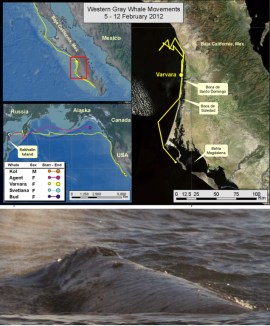
As Tim Johnson explains in this report, gray whales once swam in the north Atlantic and Pacific. Atlantic grays were wiped out by whaling. Surviving Western and Eastern Pacific grays are thought to migrate north-south from feeding to breeding grounds along opposite continental coasts. Scientists worry that gas-oil drilling in the Western grays’ Russian feeding grounds may doom them. But a few have now been tracked making amazing, perhaps survival-driven journeys to surprising parts of the globe. Varvara (left) just swam from Russia’s Sakhalin Island across to Alaska and down to Baja. Whoa! What’s next? By Tim Johnson, McClatchy Newspapers, The Kansas City Star (2/16/12).
Dolphins Still Stranding, No One Know Why
 Some dolphins and whales strand in Cape Cod every year, possibly because the Cape’s hooked shape acts as a natural trap. But never have so many stranded in so short a time: 177 common dolphins in one month — 53 rescued, 124 dead. And still they keep stranding, and still no one knows why. AP, CBS News (2/16/12)
Some dolphins and whales strand in Cape Cod every year, possibly because the Cape’s hooked shape acts as a natural trap. But never have so many stranded in so short a time: 177 common dolphins in one month — 53 rescued, 124 dead. And still they keep stranding, and still no one knows why. AP, CBS News (2/16/12)

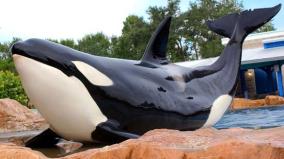
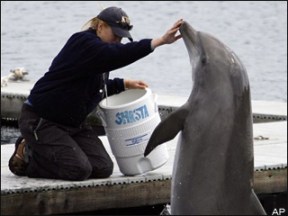


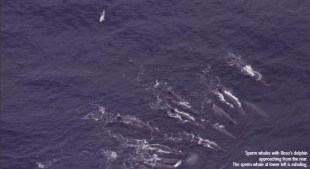


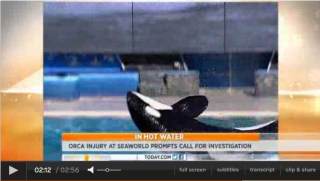
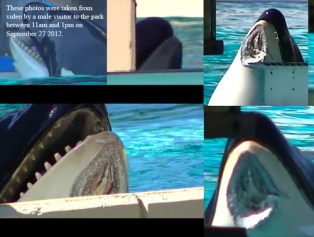



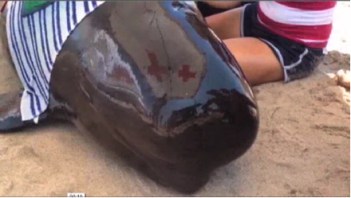











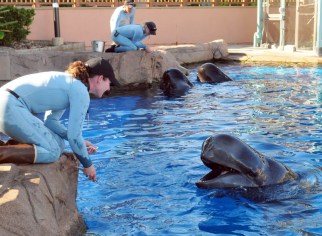


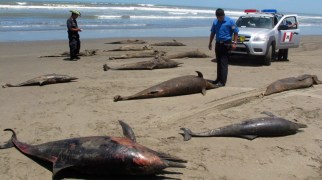


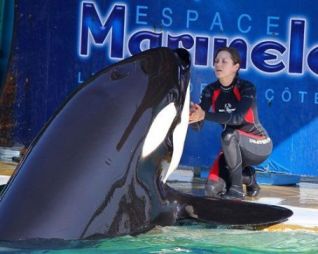



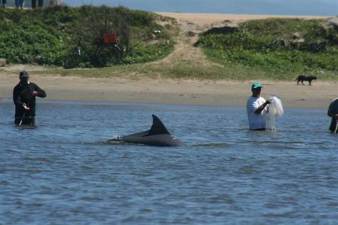
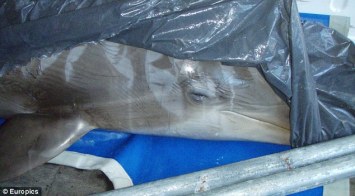
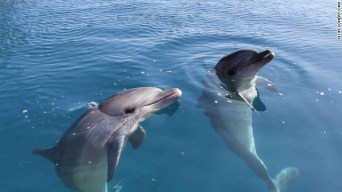

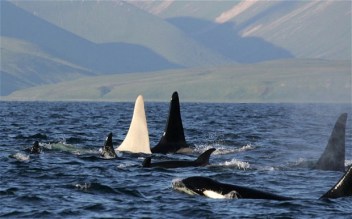

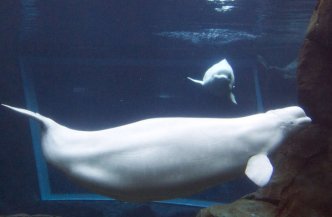




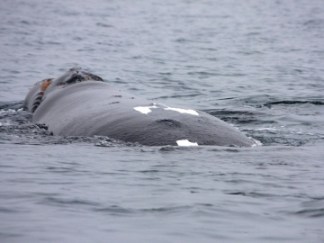
Love this page. Thank you for all the updated information that never seems to make the news. As a huge lover of Killer Whales I was lucky to fall upon this site. Thank you!
LikeLike
Thank you so much! Your kind words will help keep me going!
LikeLike
Here is an article that etatmise a population of 1,665 sperm whales in the Gulf. All of this is new to me. Interesting and disturbing, in parts. Biologists with the Minerals Management Service are attempting to identify the fish and squid species preferred by the etatmised 1,665 sperm whales that call the Gulf their home. Gulf sperm whales are genetically distinct and smaller than sperm whales found in other oceans. Research indicates that the Gulf sperm whale subspecies can sustain no more than an average 2.8 human-caused deaths each year without threatening its recovery to a non-endangered status.
LikeLike